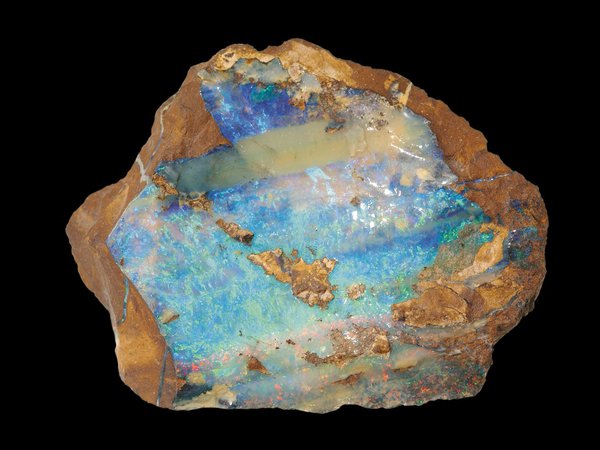Australian Museum Opal Collection
The Australian Museum Opal Collection includes opals from both sedimentary and volcanic origins, ranging from common and precious opals.


The collection
The Opal Collection includes opals from both sedimentary and volcanic origins, common opal or ‘potch’ (those without a colour play), and precious opal showing a rainbow-like colour spectrum.
Known as Australia's national gemstone, about 95 per cent of the world’s opals come from Australia.
Possibly the first official mentions of precious opal in the Australian Museum’s collection were notes in the 1873 Annual Report and Catalogue of the Minerals and Rocks in the Collection of the Australian Museum by Gerard Krefft, the Museum’s then Curator. They both mention a donation of precious opal by S L Bensusan from the south-western Queensland opal fields that were being discovered at the time.
However, European common and precious opal specimens had been purchased earlier in 1861 from Saemann of Paris, from Ward & Howell in the USA, and private donors in the late 1880s and 90s. Overseas purchases also included the famous former Hungarian opal from the Cervenica region which is now in Slovakia. Many examples of common opal, especially from New South Wales are in the D A Porter Collection, purchased in 1901.
Precious opal specimens from White Cliffs, New South Wales, were acquired in the late 1890s. White Cliffs is the home of rare opal ‘pineapples’, named after their resemblance to the top of the spiky fruit. They occur as a result of opal replacing and taking on the form of the radiating crystal clusters of the mineral ikaite.
The Museum’s first precious opal ‘pineapple’ specimens were purchased in 1904 from pioneer dealer E F Murphy who first came to White Cliffs in 1890. Another nine White Cliffs precious opal specimens came with the George Smith Collection, acquired in 1907. Smith’s 1927 collection has 69 Australian and overseas opals, including examples from Lightning Ridge and White Cliffs, and ‘crystal opal’ from volcanic rock at Tintenbar in New South Wales. A set of 13 White Cliffs and Lightning Ridge opals was also purchased from W Perry in 1932. Opalised pelecypod and gastropod shells from White Cliffs were purchased from E F Murphy & Company in 1937.

Superb precious opal pieces from well-known Sydney jeweller Percy Marks were donated and purchased in 1938. These came from areas such as Lightning Ridge and White Cliffs in New South Wales, Andamooka and Coober Pedy in South Australia, and Grawin in Queensland.
In 1976 a very fine set of 15 Lightning Ridge opals, including black opals, was also purchased from Percy Marks jewellers.
Many of these opals are very high-quality pieces that show a superb colour spectrum and have been on display in all mineral exhibitions since their acquisition.

Black opal, Lightning Ridge, South Australia. 1.68 x 1.07 x 0.44 cm, 4.8 ct. D.44323.
Image: Ross Pogson © Australian MuseumThe Australian Museum has made other notable purchases and acquisitions. In 1972, precious amber ‘jelly opal’ and ‘crystal opal’ types of volcanic origin were collected from rhyolite rocks at Mullumbimby in northern New South Wales by Curator of Minerals R Oliver Chalmers. In 1975 a beautiful ‘mirror image’ pair of colourful opal on quartzite specimens of the type called ‘Painted Lady’ from White Dam, Andamooka, South Australia was purchased.
The Taxation Incentives for the Arts Scheme in 1987 saw the donation of a magnificent large collection of superb boulder opal specimens and cabochons from Quilpie, Queensland, as well as a large polished opal cabochon, the ‘Desert Beauty’ of 290 carats, fashioned from an opalised pelecypod shell from Coober Pedy, South Australia. A polished 10.4 carat cabochon of Ethiopian fire opal was donated under the Cultural Gifts Program in 2006. A set of 14 mainly Australian opal specimens from Andamooka and Coober Pedy, South Australia, Grawin, Queensland, Glengarry, Victoria and White Cliffs, New South Wales, was donated by the family of Jack Taylor, a founding Member of the Gemmological Association of Australia.

There are a number of outstanding opal specimens within some of the Museum’s other famous collections. Acquired in 1995, the Albert Chapman Collection has a fine set of 28 opals from Coober Pedy and Andamooka, South Australia; Quilpie, Queensland; and White Cliffs, New South Wales, including an opal ‘pineapple’. The Warren Somerville Collection donated in 2000 has 26 opals from Mintabie and Andamooka in South Australia; Quilpie, Queensland; Coober Pedy and White Cliffs in New South Wales, and also includes an opal ‘pineapple’.





